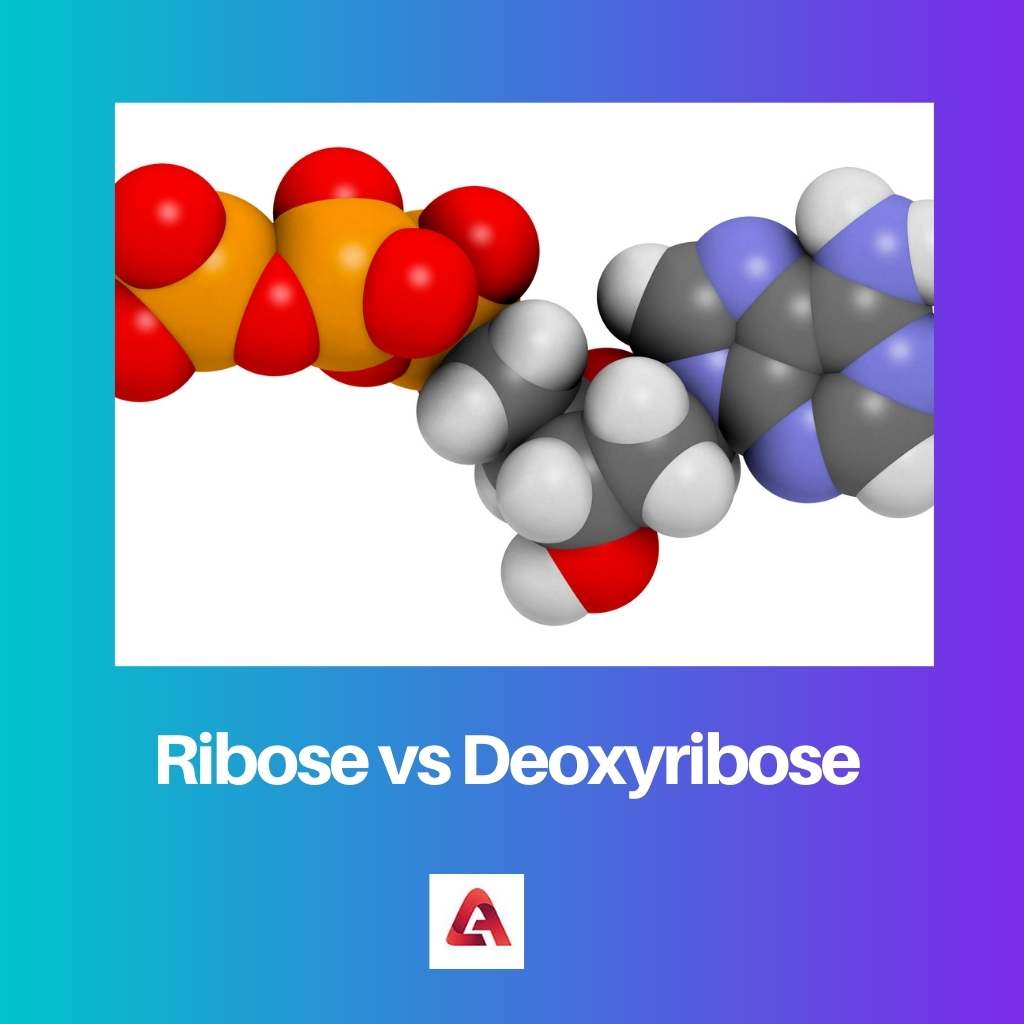Ribose and Deoxyribose have almost the same form, but due to the loss of an OH employer of their second ring function, they are taken into consideration as one in a kind from each exclusive.
The responsibilities performed via ribose and deoxyribose are carried out in a comparable way, what makes them distinctive from each other is the process and outcome. Let us understand the difference between ribose and deoxyribose in detail.
Key Takeaways
- Ribose is a pentose sugar with five carbon atoms, while deoxyribose lacks one oxygen atom, giving it a slightly different structure.
- Ribose is a key component of RNA molecules, whereas deoxyribose forms the backbone of DNA molecules.
- Deoxyribose provides greater stability to DNA, allowing it to store genetic information for long periods, while RNA’s ribose structure enables more diverse functions.
Ribose vs Deoxyribose
Ribose is a 5-carbon sugar with the chemical formula C5H10O5. Deoxyribose is a 5-carbon sugar with the chemical formula C5H10O4. RNA is more single-stranded and more dynamic than DNA, which is double-stranded and more stable. The difference in structure also affects their nucleic acids.

Ribose ( H−(C=O)−(CHOH)4−H ) is a simple sugar consisting of five carbon atoms, five oxygen atoms and ten hydrogen atoms. Ribose is chargeable for the formation of ribonucleotides.
The ribonucleotides are considered very vital as they assist in carrying out different processes. It’s far a monosaccharide that acts as a base component and is liable for forming the building blocks of RNA strands.
Deoxyribose (monosaccharide) has an identical variety of carbon and hydrogen atoms, however, dropping an oxygen atom.
The constructing block of molecules of DNA is deoxyribose and it is also known via the call aldopentose because of an aldehyde group which is connected to the structure of this molecule.
Deoxyribose performs a chief position within the formation of the double helix shape of the DNA.
Comparison Table
| Parameters of Comparison | Ribose | Deoxyribose |
|---|---|---|
| Definition | It is a simple sugar which is one of the major components required by both DNA and RNA | It is a monosaccharide acts as a building block of DNA molecules |
| Chemical formula | C5H10O5 | C5H10O4 |
| Location | RNA | DNA |
| Structure | Pentagon that stays stable with oxygen atom | Its structure is like a pentagon that has a loss of an -OH group in the second ring position |
| Discovered | Emil Fischer – 1891 | Phoebus Levene – 1929 |
What is Ribose?
An organic compound which may be classified as a monosaccharide or simple sugar is ribose. It turned into discovered by way of Emil Fischer in the year 1891.
Ribose composes five carbon atoms and ten hydrogen atoms it additionally has five oxygen atoms that are bonded collectively.
It’s miles a pentose sugar, which means that it has 5 carbons which shape the ribose’s main shape, giving it a pentagonal form.
Ribose is likewise called Aldo pentose, in which an aldehyde is a functional organization, in function, one is a gift.
There is an aldehyde institution connected to the structure of ribose that is bonded to a hydrogen atom and double-bonded to an oxygen atom properly.
Ribose could be very vital in biology internationally due to the fact a shape of it is far used in DNA which is deoxyribose nucleic acid.
It forms a hoop including five individuals of 4 carbon atoms and one oxygen.
Hydroxyl companies i.e. –OH, are attached to each of the 3-carbon, and the fourth carbon gift inside the ring has attached to it the 5th carbon atom and a hydroxyl group.
The difference in the structure of ribose and deoxyribose is without problems seen by means of counting the number of hydrogen, carbon and oxygen atoms.
There are overall of 5 carbon atoms, ten hydrogen atoms and five oxygen atoms present in ribose, but in the case of deoxyribose, there is the presence of
What is Deoxyribose?
It is a pentose monosaccharide or a simple sugar taken into consideration as one of the primary components concerned with the formation of the DNA, and it’s far discovered within the DNA as properly.
It has one much less oxygen atom in its structure, and the chemical composition of deoxyribose is C5H10O4. It was first observed by means of Phoebus Levene in the year 1929, who is additionally recognized to have discovered DNA.
The presence of two enantiomers which might be D-2-deoxyribose and L-2-deoxyribose, wherein the previous is the essential aspect of the DNA, and the latter is not often found in nature.
It is also referred to as aldopentose because of the attachment of the aldehyde group in its shape.
The goods of deoxyribose play a crucial position in biology and all existence bureaucracy, DNA is the primary source of genetic material, and adenine, thiamine, guanine, and cytosine are among the DNA nucleotides.
Deoxyribose is crucial for our body because it paperwork an important part of our DNA.
It is the spine of the double helical shape of DNA, and it is also the constructing block of the chromosomes found in our nucleus and deoxyribose bureaucracy deoxyribonucleotides via combining with adenine, guanine, thymine and cytosine.
Main Difference Between Ribose and Deoxyribose
- Ribose has a total of 5 oxygen atoms, but deoxyribose has one less oxygen atom, which is 4, this is the main difference between the two types of simple sugars.
- Both ribose and deoxyribose are simple sugars, but ribose has 5 oxygen atoms, whereas deoxyribose has four oxygen atoms.
- Ribose and deoxyribose have different IUPAC names as well. Ribose: (2S,3R,4S,5R)-5-(hydroxymethyl)oxolane-2,3,4-triol and Deoxyribose: 2-deoxy-D-ribose or 2-deoxy-D-erythro-pentose.
- RNA involves Ribose formation, whereas Deoxyribose forms DNA.
- The two sugars differ from each other on the basis of their discoveries. Ribose – Emil Fisher (1891) and deoxyribose – Phoebus Levene (1921).




